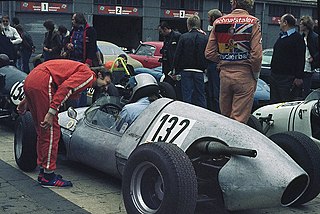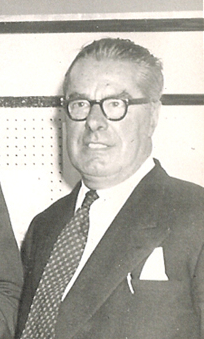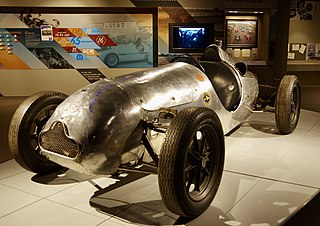History
The Mark IV came in a standard version (T11) for F3, and long-wheelbase (T12) variant for F2. [1] Standard for the T11 was a 498 cc (30.4 cu in) one-cylinder Speedway JAP engine. [2] The T12 was powered by a 1000cc engine. [1] The first 500 modified with a 1000cc JAP twin was prepared by customer Spike Rhiando in 1948. [2] In 1949, a model powered by the 1,250 cc (76 cu in) engine from an MG TD was built, and won on its first outing. [2] Cliff Davis was the most successful driver to campaign one.
Cars were supplied without engines, which the customer provided. [1] (This would become routine in Formula One in later years.) The T12s were best-suited for hillclimbs and sprints, not being durable enough for longer events. [2]
The F2 Mark IV, based on the TD-engined variant, appeared in 1952. It was powered by a 127 hp (95 kW)1,971 cc (120.3 cu in) Bristol inline six, [2] giving up 50 hp (37 kW) to the Ferraris. At just 1,000 lb (450 kg), they had 400 lb (180 kg) on the Ferraris, and better cornering, due to their mid-mounted engines. It made its debut in at Goodwood on Easter Monday, run by Eric Brandon and Alan Brown (for Ecurie Richmond ) and Mike Hawthorn (driving for Bob Chase). [2] Hawthorn took the Formula Two event and one of the two Formula Libre races, [2] and came second behind González' 4½ l Ferrari in another Libre outing. It marked the first mid-engined entrant in Formula Two, [1] and only the second marque in top-rank European racing, following Auto Union.
Mark IVs competed successfully in F2 throughout 1952 and 1953, [3] driven by Hawthorn, Peter Collins, and of course John Cooper himself, among others. [1] (Stirling Moss' unsuccessful Cooper-Alta was actually built by a different John Cooper, Autocar 's sport editor.) [3] In September 1950, Raymond Sommer died in a wreck at Cadours in a T12. [1] It sold used at £425 in 1952. [1]
Arthur Owen modified a Mark IV with a streamlined glassfibre body and 250cc Norton engine late in 1957. Bill Knight used this car to set five speed records at Monza. [1]

The Cooper Car Company is a British car manufacturer founded in December 1947 by Charles Cooper and his son John Cooper. Together with John's boyhood friend, Eric Brandon, they began by building racing cars in Charles's small garage in Surbiton, Surrey, England, in 1946. Through the 1950s and early 1960s they reached motor racing's highest levels as their mid-engined, single-seat cars competed in both Formula One and the Indianapolis 500, and their Mini Cooper dominated rally racing. The Cooper name lives on in the Cooper versions of the Mini production cars that are built in England, but is now owned and marketed by BMW.

Formula Two is a type of open-wheel formula racing category first codified in 1948. It was replaced in 1985 by Formula 3000, but revived by the FIA from 2009–2012 in the form of the FIA Formula Two Championship. The name returned in 2017 when the former GP2 Series became known as the FIA Formula 2 Championship.

Formula Three, also called Formula 3, abbreviated as F3, is a third-tier class of open-wheel formula racing. The various championships held in Europe, Australia, South America and Asia form an important step for many prospective Formula One drivers.

Dino was a marque best known for mid-engined, rear-drive sports cars produced by Ferrari from 1957 to 1976. The marque came into existence in late 1956 with a front-engined Formula Two racer powered by a brand new Dino V6 engine. The name Dino was used for some models with engines smaller than 12 cylinders, it was an attempt by the company to offer a relatively low-cost sports car. The Ferrari name remained reserved for its premium V12 and flat-12 models until 1976, when "Dino" was retired in favour of full Ferrari branding.

The Ferrari Lampredi engine was a naturally aspirated all aluminum 60° V12 engine produced between 1950 and 1959. Inline-4 and Inline-6 variants for racing were derived from it.

Henry O'Reilly "Harry" Schell was an American Grand Prix motor racing driver. He was the first American driver to start a Formula One Grand Prix.
William Simpson Aston was a British racing driver who participated in three World Championship Grands Prix, in 1952 when the championship was run to Formula Two rules, for his own team Aston Butterworth.
Eric Brandon was a motor racing driver and businessman. He was closely associated with the Cooper Car Company, and was instrumental in the early development of the company.
Ian Ewart Raby was a British racing driver from England. He participated in 7 World Championship Formula One Grands Prix, debuting on 20 July 1963 in the British Grand Prix, where he retired on Lap 60. He scored no championship points. He was a garage-owner in Brighton, Sussex trading as Empire Cars Ltd. As a privateer he came to Formula One late in life.

Formula Junior is an open wheel formula racing class first adopted in October 1958 by the CSI. The class was intended to provide an entry level class where drivers could use inexpensive mechanical components from ordinary automobiles. The idea to form the new class came from Count Giovanni "Johnny" Lurani who saw the need of a class for single-seater racing cars where younger drivers could take their first steps. It is often speculated that this class was founded as a reaction to Italy's lack of success in the 500cc Formula Three, and although Italian marques dominated the first year of the formula, they were soon overtaken by British constructors.
Ferrari used its 2 L (1995 cc/121 in3) V12 engine in a number of models, all called 166 for the displacement of a single cylinder. Most early 166es were sports cars built for racing, though a later line of GT cars launched the company's street model line.

The Ferrari 246 F1 is a Ferrari racing car built for the Formula One World Championship of 1958.

Charles Newton "Charlie" Cooper was a British motorsport mechanic, designer and entrepreneur.
The Cooper Mk.V, is a series of three different Formula 3 cars, designed, developed and built by Cooper Cars in 1951. Like its predecessor, it used a 500 cc (31 cu in) JA Prestwich Industries (JAP) single-cylinder engine, or a 1,000–1,100 cc (61–67 cu in) JA Prestwich Industries (JAP) V-2 engine. The first version was the short-wheelbase Cooper T15; which featured a box-section chassis frame, detachable body panels, and a rack-and-pinion steering system. The second version was the long wheelbase Cooper T16, which featured a lengthened wheelbase to be able to equip the larger 1 L (61 cu in) engine. And the third and final version, the Cooper T17; which was a special streamliner version land speed record attempt car for speed record attempts, and sometimes, used for fast road racing circuits.

The Cooper Mk.VIII is a Formula 3 car built by British manufacturer Cooper Cars in 1954. It came in three different versions. The first was the Cooper T31; which featured a curved tubular chassis, a revised transmission housing, a central scuttle tank, a "curled-leaf" spring, and a 500 cc (31 cu in) JA Prestwich Industries (JAP) single-cylinder engine. The second version was the Cooper T32; which featured an elongated chassis and body, and a larger and more powerful 1,100 cc (67 cu in) OHV V-2 engine. The third and final iteration was the Cooper T28; which was a streamliner designed for setting speed records.

The Cooper Mark II, also known as the T5 , was a 500cc open-wheel racing car designed and built by the Cooper Car Company at Surbiton, Surrey, England, in 1948, and was the first production car made by Cooper. It was a successor to 1946 Cooper 500, which was a prototype. 12 cars were built. It was powered by a 45 hp (34 kW) 500 cc (31 cu in) JA Prestwich Industries (JAP) 4B Speedway single-cylinder engine, but had the option of being converted to a lengthened wheelbase version, to be able to use a 70 hp (52 kW) 1,000 cc (61 cu in) JA Prestwich Industries (JAP) or Vincent-HRD V-twin. It also notably won the first ever Grand Prix at Silverstone in 1948, competing in the 500 cc class, being driven by Spike Rhiando.

The Cooper Mark III is a Formula Three open-wheel racing car designed and developed by the Cooper Car Company in Surbiton, Surrey, England, and built in 1949. It was the successor to the Mk.II, and was offered in two versions. The first option was the T7 ; which was powered by a powered by a 40 hp (30 kW) 500 cc (31 cu in) JA Prestwich Industries (JAP) 4B Speedway single-cylinder OHV motorcycle engine. The second option was the T9 ; which featured a longer chassis, with an elongated wheelbase, and used a larger and more powerful 70 hp (52 kW) 1,000 cc (61 cu in) JA Prestwich Industries (JAP) V-twin motorcycle engine. For the first time ever, a ZF limited slip differential was also offered as an optional extra for customers.

The Ferrari 166 F2 is an open-wheel formula racing single-seater car, designed, developed and built by Italian manufacturer and team Scuderia Ferrari, for Formula 2 racing, in 1948. This is the car in which Argentinian driver, and eventual five-time Formula One world champion, Juan Manuel Fangio, became known in Europe.
The Cooper Mk.X, and its evolutions, the Mk.XI, the Mk.XII, and the Mk.XIII, are open-wheel Formula Three race cars, designed, developed, and built by British manufacturer Cooper in 1956. It was virtually identical in design to the previous Mk.IX. The internal designation, dubbed the T42, was powered by a 500 cc (31 cu in) JA Prestwich Industries (JAP) single-cylinder engine, and featured a singular brake disk at the rear of the car, flatter springs to mitigate ground clearance, altered and adjusted center spring mountings, and reworked engine mounts. The second version featured an elongated chassis and body, and a larger and more powerful 1,000 cc (61 cu in) OHV V-2 engine. Weight and chassis dimensions were essentially identical to the previous model.















